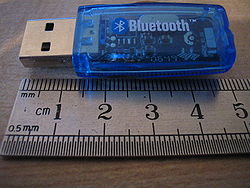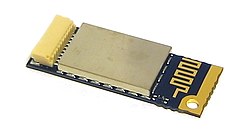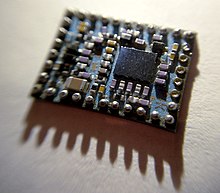Bluetooth vs Wi-Fi (IEEE 802.11)[edit]
Bluetooth and Wi-Fi (Wi-Fi is the brand name for products using IEEE 802.11 standards) have some similar applications: setting up networks, printing, or transferring files. Wi-Fi is intended as a replacement for high-speed cabling for general local area network access in work areas or home. This category of applications is sometimes called wireless local area networks (WLAN). Bluetooth was intended for portable equipment and its applications. The category of applications is outlined as the wireless personal area network (WPAN). Bluetooth is a replacement for cabling in various personally carried applications in any setting and also works for fixed location applications such as smart energy functionality in the home (thermostats, etc.).
Wi-Fi and Bluetooth are to some extent complementary in their applications and usage. Wi-Fi is usually access point-centered, with an asymmetrical client-server connection with all traffic routed through the access point, while Bluetooth is usually symmetrical, between two Bluetooth devices. Bluetooth serves well in simple applications where two devices need to connect with a minimal configuration like a button press, as in headsets and speakers.
Devices[edit]
Bluetooth exists in numerous products such as telephones, speakers, tablets, media players, robotics systems, laptops, and game console equipment as well as some high definition headsets, modems, hearing aids[52] and even watches.[53] Given the variety of devices which use Bluetooth, coupled with the contemporary deprecation of headphone jacks by Apple, Google, and other companies, and the lack of regulation by the FCC, the technology is prone to interference.[54] Nonetheless, Bluetooth is useful when transferring information between two or more devices that are near each other in low-bandwidth situations. Bluetooth is commonly used to transfer sound data with telephones (i.e., with a Bluetooth headset) or byte data with hand-held computers (transferring files).
Bluetooth protocols simplify the discovery and setup of services between devices.[55] Bluetooth devices can advertise all of the services they provide.[56] This makes using services easier, because more of the security, network address and permission configuration can be automated than with many other network types.[55]
Computer requirements[edit]
A personal computer that does not have embedded Bluetooth can use a Bluetooth adapter that enables the PC to communicate with Bluetooth devices. While some desktop computers and most recent laptops come with a built-in Bluetooth radio, others require an external adapter, typically in the form of a small USB "dongle."
Unlike its predecessor, IrDA, which requires a separate adapter for each device, Bluetooth lets multiple devices communicate with a computer over a single adapter.[57]
Operating system implementation[edit]
For Microsoft platforms, Windows XP Service Pack 2 and SP3 releases work natively with Bluetooth v1.1, v2.0 and v2.0+EDR.[58] Previous versions required users to install their Bluetooth adapter's own drivers, which were not directly supported by Microsoft.[59] Microsoft's own Bluetooth dongles (packaged with their Bluetooth computer devices) have no external drivers and thus require at least Windows XP Service Pack 2. Windows Vista RTM/SP1 with the Feature Pack for Wireless or Windows Vista SP2 work with Bluetooth v2.1+EDR.[58] Windows 7 works with Bluetooth v2.1+EDR and Extended Inquiry Response (EIR).[58] The Windows XP and Windows Vista/Windows 7 Bluetooth stacks support the following Bluetooth profiles natively: PAN, SPP, DUN, HID, HCRP. The Windows XP stack can be replaced by a third party stack that supports more profiles or newer Bluetooth versions. The Windows Vista/Windows 7 Bluetooth stack supports vendor-supplied additional profiles without requiring that the Microsoft stack be replaced.[58] Windows 8 and later support Bluetooth Low Energy (BLE). It is generally recommended to install the latest vendor driver and its associated stack to be able to use the Bluetooth device at its fullest extent.
Apple products have worked with Bluetooth since Mac OS X v10.2, which was released in 2002.[60]
Linux has two popular Bluetooth stacks, BlueZ and Fluoride. The BlueZ stack is included with most Linux kernels and was originally developed by Qualcomm.[61] Fluoride, earlier known as Bluedroid is included in Android OS and was originally developed by Broadcom.[62] There is also Affix stack, developed by Nokia. It was once popular, but has not been updated since 2005.[63]
FreeBSD has included Bluetooth since its v5.0 release, implemented through netgraph.[64][65]
NetBSD has included Bluetooth since its v4.0 release.[66][67] Its Bluetooth stack was ported to OpenBSD as well, however OpenBSD later removed it as unmaintained.[68][69]
DragonFly BSD has had NetBSD's Bluetooth implementation since 1.11 (2008).[70][71] A netgraph-based implementation from FreeBSD has also been available in the tree, possibly disabled until 2014-11-15, and may require more work.[72][73]
You received this message because you are subscribed to the Google Groups "1TopReadys1" group.
To unsubscribe from this group and stop receiving emails from it, send an email to 1topreadys1+unsubscribe@googlegroups.com.
To view this discussion on the web visit https://groups.google.com/d/msgid/1topreadys1/CAForgrRCE7ooG6oQXu6NNKWTjUw%3Djj7vmxAnsOz2wNr59uE3zw%40mail.gmail.com.






